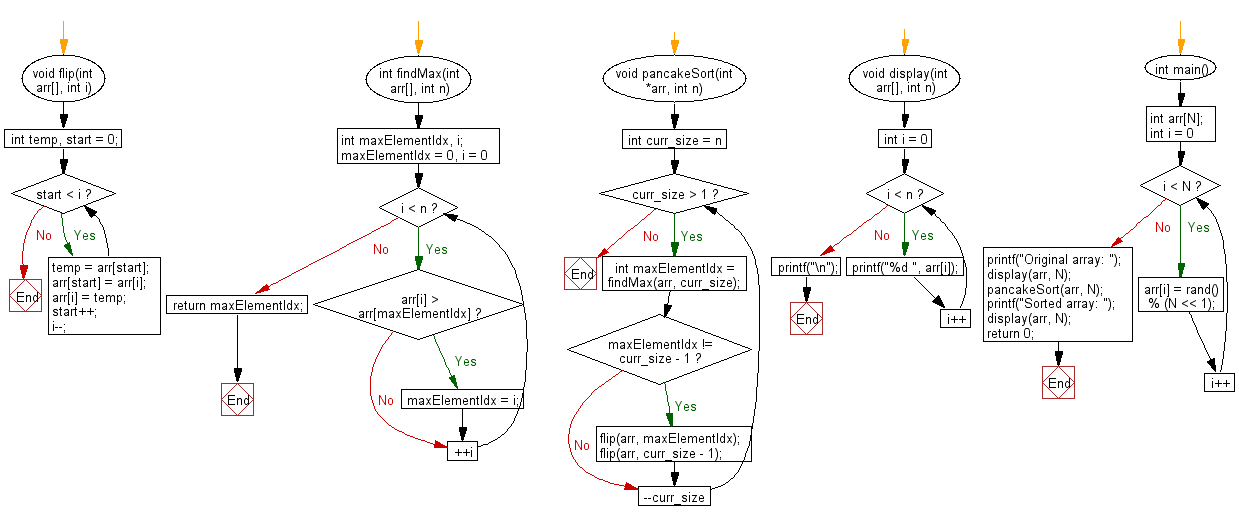C Exercises: Sort numbers using Pancake Sort method
22. Pancake Sort Variants
Write a C program that sorts numbers using the Pancake sort method.
From Wikipedia,
Pancake sorting is the colloquial term for the mathematical problem of sorting a disordered stack of pancakes in order of size when a spatula can be inserted at any point in the stack and used to flip all pancakes above it. A pancake number is the minimum number of flips required for a given number of pancakes. In this form, the problem was first discussed by American geometer Jacob E. Goodman. A variant of the problem is concerned with burnt pancakes, where each pancake has a burnt side and all pancakes must, in addition, end up with the burnt side on bottom.
Sample Solution:
Sample C Code:
// Source: https://bit.ly/34Po5lN
// Sorting of array list using pancake sort
# include <stdio.h>
#include <stdlib.h>
/* Reverses the array */
void flip(int arr[], int i) {
int temp, start = 0;
while (start < i) {
temp = arr[start];
arr[start] = arr[i];
arr[i] = temp;
start++;
i--;
}
}
// Returns index of the maximum element in arr[0..n-1]
int findMax(int arr[], int n) {
int maxElementIdx, i;
for (maxElementIdx = 0, i = 0; i < n; ++i)
if (arr[i] > arr[maxElementIdx])
maxElementIdx = i;
return maxElementIdx;
}
// Sorts the array using flip operations
void pancakeSort(int *arr, int n) {
// Start from the complete array and one by one reduce current size by one
for (int curr_size = n; curr_size > 1; --curr_size) {
// Find index of the maximum element in arr[0..curr_size-1]
int maxElementIdx = findMax(arr, curr_size);
// Move the maximum element to end of current array if it's not already
// at the end
if (maxElementIdx != curr_size - 1) {
// To move at the end, first move maximum number to the beginning
flip(arr, maxElementIdx);
// Now move the maximum number to end by reversing the current array
flip(arr, curr_size - 1);
}
}
}
// Displays the array, passed to this method
void display(int arr[], int n) {
for (int i = 0; i < n; i++) {
printf("%d ", arr[i]);
}
printf("\n");
}
#define N 50
// Driver program to test the above function
int main() {
int arr[N];
// Fill the array with random numbers
for (int i = 0; i < N; i++)
arr[i] = rand() % (N << 1); /* random numbers from 0 to 2N */
printf("Original array: ");
display(arr, N);
// Sort the array using pancakeSort
pancakeSort(arr, N);
printf("Sorted array: ");
display(arr, N);
return 0;
}
Sample Output:
Original array: 83 86 77 15 93 35 86 92 49 21 62 27 90 59 63 26 40 26 72 36 11 68 67 29 82 30 62 23 67 35 29 2 22 58 69 67 93 56 11 42 29 73 21 19 84 37 98 24 15 70 Sorted array: 2 11 11 15 15 19 21 21 22 23 24 26 26 27 29 29 29 30 35 35 36 37 40 42 49 56 58 59 62 62 63 67 67 67 68 69 70 72 73 77 82 83 84 86 86 90 92 93 93 98
Flowchart:

For more Practice: Solve these Related Problems:
- Write a C program to implement pancake sort on an array of integers and display the sequence of flips performed.
- Write a C program to modify pancake sort to sort an array in descending order by adjusting the flip logic.
- Write a C program to apply pancake sort on an array of strings by comparing their lexicographical order.
- Write a C program to combine pancake sort with binary search to optimize the flip operations.
Go to:
PREV : Partition Sort Variants.
NEXT : Multi-key Quicksort Variants.
C Programming Code Editor:
Have another way to solve this solution? Contribute your code (and comments) through Disqus.
What is the difficulty level of this exercise?
Test your Programming skills with w3resource's quiz.
